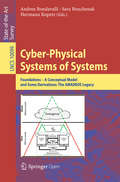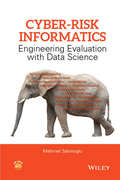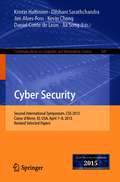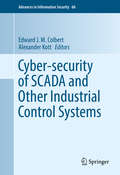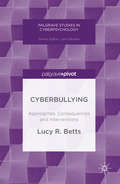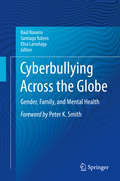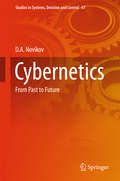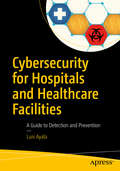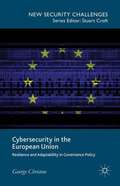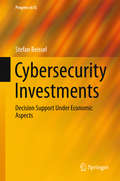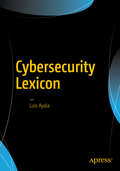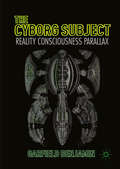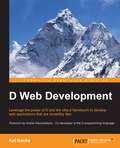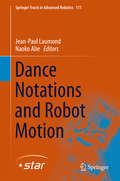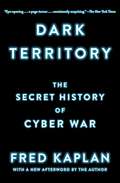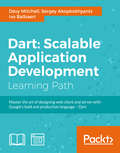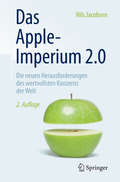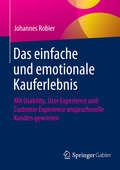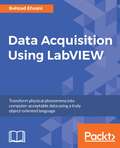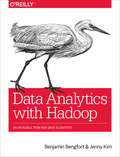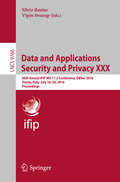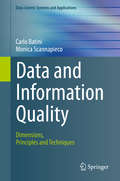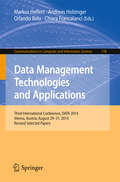- Table View
- List View
Cyber-Physical Systems of Systems: Foundations – A Conceptual Model and Some Derivations: The AMADEOS Legacy (Lecture Notes in Computer Science #10099)
by Hermann Kopetz Andrea Bondavalli Sara BouchenakThis book is open access under a CC BY 4. 0 license. Technical Systems-of-Systems (SoS) - in the form of networked, independent constituent computing systems temporarily collaborating to achieve a well-defined objective - form the backbone of most of today's infrastructure. The energy grid, most transportation systems, the global banking industry, the water-supply system, the military equipment, many embedded systems, and a great number more, strongly depend on systems-of-systems. The correct operation and continuous availability of these underlying systems-of-systems are fundamental for the functioning of our modern society. The 8 papers presented in this book document the main insights on Cyber-Physical System of Systems (CPSoSs) that were gained during the work in the FP7-610535 European Research Project AMADEOS (acronym for Architecture for Multi-criticality Agile Dependable Evolutionary Open System-of-Systems). It is the objective of this book to present, in a single consistent body, the foundational concepts and their relationships. These form a conceptual basis for the description and understanding of SoSs and go deeper in what we consider the characterizing and distinguishing elements of SoSs: time, emergence, evolution and dynamicity.
Cyber-Risk Informatics: Engineering Evaluation with Data Science
by Mehmet SahinogluThis book provides a scientific modeling approach for conducting metrics-based quantitative risk assessments of cybersecurity vulnerabilities and threats. This book provides a scientific modeling approach for conducting metrics-based quantitative risk assessments of cybersecurity threats. The author builds from a common understanding based on previous class-tested works to introduce the reader to the current and newly innovative approaches to address the maliciously-by-human-created (rather than by-chance-occurring) vulnerability and threat, and related cost-effective management to mitigate such risk. This book is purely statistical data-oriented (not deterministic) and employs computationally intensive techniques, such as Monte Carlo and Discrete Event Simulation. The enriched JAVA ready-to-go applications and solutions to exercises provided by the author at the book's specifically preserved website will enable readers to utilize the course related problems. * Enables the reader to use the book's website's applications to implement and see results, and use them making 'budgetary' sense * Utilizes a data analytical approach and provides clear entry points for readers of varying skill sets and backgrounds * Developed out of necessity from real in-class experience while teaching advanced undergraduate and graduate courses by the author Cyber-Risk Informatics is a resource for undergraduate students, graduate students, and practitioners in the field of Risk Assessment and Management regarding Security and Reliability Modeling. Mehmet Sahinoglu, a Professor (1990) Emeritus (2000), is the founder of the Informatics Institute (2009) and its SACS-accredited (2010) and NSA-certified (2013) flagship Cybersystems and Information Security (CSIS) graduate program (the first such full degree in-class program in Southeastern USA) at AUM, Auburn University's metropolitan campus in Montgomery, Alabama. He is a fellow member of the SDPS Society, a senior member of the IEEE, and an elected member of ISI. Sahinoglu is the recipient of Microsoft's Trustworthy Computing Curriculum (TCC) award and the author of Trustworthy Computing (Wiley, 2007).
Cyber Security: Second International Symposium, CSS 2015, Coeur d'Alene, ID, USA, April 7-8, 2015, Revised Selected Papers (Communications in Computer and Information Science #589)
by Kristin Haltinner Dilshani Sarathchandra Jim Alves-Foss Kevin Chang Daniel Conte de Leon Jia SongThis book constitutes the refereed proceedings of the Second International Symposium on Cyber Security, CSS 2015, held in Coeur d'Alene, ID, USA, in April 2015. The 9 revised full papers presented were carefully reviewed and selected from 20 papers. The papers reflect four areas of scholarly work: permissions and trust evaluation, implementation and management; cloud and device security and privacy; social implications of networked and mobile applications; system and process assessments for improved cybersecurity.
Cyber Security and the Politics of Time
by Tim Stevens'Cyber security' is a recent addition to the global security agenda, concerned with protecting states and citizens from the misuse of computer networks for war, terrorism, economic espionage and criminal gain. Many argue that the ubiquity of computer networks calls for robust and pervasive countermeasures, not least governments concerned at their potential effects on national and economic security. Drawing on critical literature in international relations, security studies, political theory and social theory, this is the first book that describes how these visions of future cyber security are sustained in the communities that articulate them. Specifically, it shows that conceptions of time and temporality are foundational to the politics of cyber security. It explores how cyber security communities understand the past, present and future, thereby shaping cyber security as a political practice. Integrating a wide range of conceptual and empirical resources, this innovative book provides insight for scholars, practitioners and policymakers.
Cyber-security of SCADA and Other Industrial Control Systems (Advances in Information Security #66)
by Alexander Kott Edward J. M. ColbertThis book provides a comprehensive overview of the fundamental security of Industrial Control Systems (ICSs), including Supervisory Control and Data Acquisition (SCADA) systems and touching on cyber-physical systems in general. Careful attention is given to providing the reader with clear and comprehensive background and reference material for each topic pertinent to ICS security. This book offers answers to such questions as: Which specific operating and security issues may lead to a loss of efficiency and operation? What methods can be used to monitor and protect my system? How can I design my system to reduce threats? This book offers chapters on ICS cyber threats, attacks, metrics, risk, situational awareness, intrusion detection, and security testing, providing an advantageous reference set for current system owners who wish to securely configure and operate their ICSs. This book is appropriate for non-specialists as well. Tutorial information is provided in two initial chapters and in the beginnings of other chapters as needed. The book concludes with advanced topics on ICS governance, responses to attacks on ICS, and future security of the Internet of Things.
Cyberbullying: Approaches, Consequences and Interventions (Palgrave Studies in Cyberpsychology)
by Lucy R. BettsDrawing on research evidence and media coverage, this book explores a number of key debates surrounding cyberbullying. The increasing digitization of society affords many benefits; however, some of these benefits are offset by more adverse consequences. Cyberbullying represents one of the adverse consequences of technology use, which has become a topic of increasing societal concern. Betts adopts a critical stance to exploring issues around the definition of cyberbullying, the unique nature of cyberbullying compared to other forms of bullying, the variation in the reported prevalence rates of cyberbullying, the consequences of involvement in cyberbullying, and the steps that can be taken to tackle cyberbullying.
Cyberbullying Across the Globe: Gender, Family, and Mental Health
by Raúl Navarro Santiago Yubero Elisa LarrañagaThis book provides a much-needed analysis of the current research in the global epidemic of electronic bullying. Scholars and professionals from the Americas, Europe, and Asia offer data, insights, and solutions, acknowledging both the social psychology and technological contexts underlying cyberbullying phenomena. Contributors address questions that are just beginning to emerge as well as longstanding issues concerning family and gender dynamics, and provide evidence-based prevention and intervention strategies for school and home. The global nature of the book reflects not only the scope and severity of cyberbullying, but also the tenacity of efforts to control and eradicate the problem. Included in the coverage: * Gender issues and cyberbullying in children and adolescents: from gender differences to gender identity measures. * Family relationships and cyberbullying. * Examining the incremental impact of cyberbullying on outcomes over and above traditional bullying in North America. * A review of cyberbullying and education issues in Latin America. * Cyberbullying prevention from child and youth literature. * Cyberbullying and restorative justice. Cyberbullying across the Globe is an essential resource for researchers, graduate students, and other professionals in child and school psychology, public health, social work and counseling, educational policy, and family advocacy.
Cybernetics: From Past to Future (Studies in Systems, Decision and Control #47)
by D. A. NovikovThis book is a concise navigator across the history of cybernetics, itsstate-of-the-art and prospects. The evolution of cybernetics (from N. Wiener tothe present day) and the reasons of its ups and downs are presented. Thecorrelation of cybernetics with the philosophy and methodology of control, aswell as with system theory and systems analysis is clearly demonstrated. The book presents a detailed analysis focusing on the modern trends ofresearch in cybernetics. A new development stage of cybernetics (the so-calledcybernetics 2. 0) is discussed as a science on general regularities of systemsorganization and control. The author substantiates the topicality ofelaborating a new branch of cybernetics, i. e. organization theory which studiesan organization as a property, process and system. The book is intended for theoreticians andpractitioners, as well as for students, postgraduates and doctoral candidates. In the first place, the target audience includes tutors and lecturers preparingcourses on cybernetics, control theory and systems science.
Cybersecurity for Hospitals and Healthcare Facilities: A Guide to Detection and Prevention
by Luis AyalaLearn how to detect and prevent the hacking of medical equipment at hospitals and healthcare facilities. A cyber-physical attack on building equipment pales in comparison to the damage a determined hacker can do if he/she gains access to a medical-grade network as a medical-grade network controls the diagnostic, treatment, and life support equipment on which lives depend. News reports inform us how hackers strike hospitals with ransomware that prevents staff from accessing patient records or scheduling appointments. Unfortunately, medical equipment also can be hacked and shut down remotely as a form of extortion. Criminal hackers will not ask for a $500 payment to unlock an MRI, PET or CT scan, or X-ray machine--they will ask for much more. Litigation is bound to follow and the resulting punitive awards will drive up hospital insurance costs and healthcare costs in general. This will undoubtedly result in increased regulations for hospitals and higher costs for compliance. Unless hospitals and other healthcare facilities take the steps necessary to secure their medical-grade networks, they will be targeted for cyber-physical attack, possibly with life-threatening consequences. Cybersecurity for Hospitals and Healthcare Facilities is a wake-up call explaining what hackers can do, why hackers would target a hospital, the way hackers research a target, ways hackers can gain access to a medical-grade network (cyber-attack vectors), and ways hackers hope to monetize their cyber-attack. By understanding and detecting the threats, you can take action now--before your hospital becomes the next victim. What You Will Learn: Determine how vulnerable hospital and healthcare building equipment is to cyber-physical attack Identify possible ways hackers can hack hospital and healthcare facility equipment Recognize the cyber-attack vectors--or paths by which a hacker or cracker can gain access to a computer, a medical-grade network server, or expensive medical equipment in order to deliver a payload or malicious outcome Detect and prevent man-in-the-middle or denial-of-service cyber-attacks Detect and prevent hacking of the hospital database and hospital web application Who This Book Is For: Hospital administrators, healthcare professionals, hospital & healthcare facility engineers and building managers, hospital & healthcare facility IT professionals, and HIPAA professionals
Cybersecurity in the European Union: Resilience And Adaptability In Governance Policy (New Security Challenges)
by George ChristouCybercrime affects over 1 million people worldwide a day, and cyber attacks on public institutions and businesses are increasing. This book interrogates the European Union's evolving cybersecurity policies and strategy and argues that while progress is being made, much remains to be done to ensure a secure and resilient cyberspace in the future.
Cybersecurity Investments: Decision Support Under Economic Aspects (Progress in IS)
by Stefan BeisselThis book offersreaders essential orientation on cybersecurity safeguards, and first andforemost helps them find the right balance between financial expenditures andrisk mitigation. This is achieved by pursuing a multi-disciplinary approach thatcombines well-founded methods from economics and the computer sciences. Established decision making techniques are embedded into a walk-through for thecomplete lifecycle of cybersecurity investments. Insights into the economic aspectof the costs and benefits of cybersecurity are supplemented by established andinnovative economic indicators. Readers will find practical tools and techniquesto support reasonable decision making in cybersecurity investments. Further,they will be equipped to encourage a common understanding using economicaspects, and to provide cost transparency for the senior management.
Cybersecurity Lexicon
by Luis AyalaThis book offers easy-to-understand definitions of cybersecurity technical terminology and hacker jargon related to automated control systems common to buildings, utilities, and industry, and explains the threats and vulnerabilities of critical infrastructure. Although written primarily for building designers and maintenance personnel, much of the terminology applies to cyber-physical attacks in general. Buildings today are automated because the systems are complicated so we depend on the building controls system (BCS) to operate the equipment. We also depend on a computerized maintenance management system (CMMS) to keep a record of what was repaired and to schedule required maintenance. SCADA, BCS, and CMMS can all be hacked. The Cybersecurity Lexicon puts cyber jargon related to building controls all in one place. The book is a handy desk reference for professionals interested in preventing cyber-physical attacks against their facilities in the real world. Discussion of cybers-physical attacks on automated control systems is clouded by a lack of standard definitions and a general misunderstanding about how bad actors can actually employ cyber technology as a weapon in the real world. The book provides: Concepts related to cyber-physical attacks and building hacks are listed alphabetically with text easily searchable by key phrase. Definitions of technical terms related to equipment controls common to industry, utilities, and buildings--much of the terminology also applies to cybersecurity in general. What you'll learn Readers will be able to quickly find cybersecurity-physical attack concepts and get a simple explanation of the meaning. Many of the most common types of cybersecurity-attacks are explained so readers can quickly assess the threat to their facilities in real time. The definition of as facilities, engineering, and cybersecurity acronyms. Who this book is for Architects, Engineers, Building Managers, Students, Researchers and Consultants interested in cybersecurity-attacks against facilities in the real world. Also for IT professionals getting involved in cybersecurity responsibilities.
The Cyborg Subject
by Garfield BenjaminThis book outlines a new conception of the cyborg in terms of consciousness as the parallax gap between physical and digital worlds. The contemporary subject constructs its own internal reality in the interplay of the Virtual and the Real. Reinterpreting the work of Slavoj Žižek and Gilles Deleuze in terms of the psychological and ontological construction of the digital, alongside the philosophy of quantum physics, this book offers a challenge to materialist perspectives in the fluid cyberspace that is ever permeating our lives. The inclusion of the subject in its own epistemological framework establishes a model for an engaged spectatorship of reality. Through the analysis of online media, digital art, avatars, computer games and science fiction, a new model of cyborg culture reveals the opportunities for critical and creative interventions in the contemporary subjective experience, promoting an awareness of the parallax position we all occupy between physical and digital worlds.
D Web Development
by Kai NackeLeverage the power of D and the vibe.d framework to develop web applications that are incredibly fast About This Book * Utilize the elegant vibe.d framework to build web applications easily and REST backends with the D programming language * Learn about all components of vibe.d to enhance your web development with D * A hands-on guide to the vibe.d framework; from static web pages to template-based, interactive and localized web applications with database access and REST backends Who This Book Is For Whether you are new to the world of D, or already have developed applications in D, or if you want to leverage the power of D for web development, then this book is ideal for you. Basic knowledge of core web technologies like HTML 5 is helpful but not required. This book explains the difficult details to speed your web development. What You Will Learn * Create amazingly fast web applications with D * Use Diet templates to easily create a web user interface * Utilize the web framework for interactive applications with input validation and internationalization * Access a database to provide persistent storage for your application * Extend your application with a REST interface and access other applications via REST * Understand vibe.d's fiber-based approach to asynchronous I/O and use it for integration of existing components * Create GUI applications with vibe.d In Detail D is a programming language with C-like syntax and static typing. The vibe.d framework builds on powerful D concepts like template meta-programming and compile-time function execution to provide an easy-to-use environment for web applications. The combination of a feature-rich web programming framework with a language compiling to native code solves two common issues in web development today: it accelerates your development and it results in fast, native web applications. Learning the vibe.d framework before you start your application will help you to choose the right features to reach your goal. This book guides you through all aspects of web development with D and the vibe.d framework. Covering the popular operating systems today, this guide starts with the setup of your development system. From the first Hello World-style application you will move on to building static web pages with templates. The concise treatment of web forms will give you all the details about form handling and web security. Using the abstractions of the web framework you will learn how to easily validate user input. Next, you will add database access to your application, providing persistent storage for your data. Building on this foundation, you will expose your component and integrate other components via REST. Learning about the internals of vibe.d you will be able to use low-level techniques such as raw TCP access. The vibe.d concepts can also be used for GUI clients, which is the next topic that you will learn. vibe.d is supported by an active community, which adds new functionality. This comprehensive guide concludes with an overview of the most useful vibe.d extensions and where to find them. It also shows you how to integrate these extensions in your application. The concepts are always illustrated with source code, giving you an insight into how to apply them in your application. Style and approach A tutorial-style guide to develop web applications with D and the vibe.d framework. Each topic is explained in detail and illustrated with source code, providing you with hands-on assistance for your application.
Dance Notations and Robot Motion (Springer Tracts in Advanced Robotics #111)
by Jean-Paul Laumond Naoko AbeHow and why to write a movement? Who is the writer? Who is the reader? They may be choreographers working with dancers. They may be roboticists programming robots. They may be artists designing cartoons in computer animation. In all such fields the purpose is to express an intention about a dance, a specific motion or an action to perform, in terms of intelligible sequences of elementary movements, as a music score that would be devoted to motion representation. Unfortunately there is no universal language to write a motion. Motion languages live together in a Babel tower populated by biomechanists, dance notators, neuroscientists, computer scientists, choreographers, roboticists. Each community handles its own concepts and speaks its own language. The book accounts for this diversity. Its origin is a unique workshop held at LAAS-CNRS in Toulouse in 2014. Worldwide representatives of various communities met there. Their challenge was to reach a mutual understanding allowing a choreographer to access robotics concepts, or a computer scientist to understand the subtleties of dance notation. The liveliness of this multidisciplinary meeting is reflected by the book thank to the willingness of authors to share their own experiences with others.
Dark Territory: The Secret History of Cyber War
by Fred Kaplan&“An important, disturbing, and gripping history&” (Kirkus Reviews, starred review), the never-before-told story of the computer scientists and the NSA, Pentagon, and White House policymakers who invent and employ cyber wars—where every country can be a major power player and every hacker a mass destroyer.In June 1983, President Reagan watched the movie War Games, in which a teenager unwittingly hacks the Pentagon, and asked his top general if the scenario was plausible. The general said it was. This set in motion the first presidential directive on computer security.From the 1991 Gulf War to conflicts in Haiti, Serbia, Syria, the former Soviet republics, Iraq, and Iran, where cyber warfare played a significant role, Dark Territory chronicles a little-known past that shines an unsettling light on our future. Fred Kaplan probes the inner corridors of the National Security Agency, the beyond-top-secret cyber units in the Pentagon, the “information warfare” squads of the military services, and the national security debates in the White House to reveal the details of the officers, policymakers, scientists, and spies who devised this new form of warfare and who have been planning—and (more often than people know) fighting—these wars for decades.“An eye-opening history of our government’s efforts to effectively manage our national security in the face of the largely open global communications network established by the World Wide Web….Dark Territory is a page-turner [and] consistently surprising” (The New York Times).
Dart: Scalable Application Development
by Davy Mitchell Ivo Balbaert Sergey AkopkokhyantsMaster the art of designing web client and server with Google's bold and productive language – Dart About This Book • Create robust applications with unit tests, documentation, and diagnostic logging • Master the core Dart language, type system, and key development tools • Connect to existing web services, process JSON, and create your own framework for the data display • Use mixins, reflections, annotations, and other metadata programming techniques to create powerful app Who This Book Is For If you are familiar with web development and are looking to learn, or even just evaluate, Dart as a multipurpose language, this learning path is for you. No familiarity with the Dart language is assumed. For beginners, it will serve as a guide to rapidly accelerate from a novice level to the master level; for intermediate to advanced developers it will quickly fill in the gaps on Dart and can explore a range of application types and powerful packages that are demonstrated in a practical manner. What You Will Learn • Handle form data and encryption • Set up your Dart environment to achieve the highest productivity • Run and debug the Dart server and web applications and compile them in JavaScript • Work with PostgreSQL—an industry standard relational database system • Create robust applications with unit tests, documentation, and diagnostic logging • Develop command-line applications, and explore the key data structures and libraries • Detect and use HTML5 features that will help you deliver rich, cross-platform content • Demonstrate the power of Polymer web components for binding data and structuring your web pages In Detail Designed to create next generation apps, Google's Dart offers a much more robust framework and also supersedes JavaScript in several aspects. Familiar yet innovative, compact yet scalable, it blows away the accumulated JavaScript legacy limitations. Dart was designed for great tool-ability and developer productivity, allowing you to create better application faster than before. Google chose it for their billion dollar advertising business and you have its power for your projects too. The first module will introduce you the Dart language starting from its conception to its current form, and where it headed is through engaging substantial practical projects. You will be taken through building typical applications and exploring the exciting new technologies of HTML5. The second module will show you how to add internalization support to your web applications and how i18n and i10n access can be embedded into your code to design applications that can be localized easily. You will be shown how to organize client-to-server communication and how different HTML5 features can be used in Dart. Finally, this module will show you how you can store data locally, break the storage limit, and prevent security issues in your web application. The third module is a pragmatic guide that will increase your expertise in writing all kinds of applications, including web apps, scripts, and server-side apps. It provides rich insights on how to extend your Dart programming skills. Altogether, this course provides you the power to create powerful applications with Dart, without worrying about your knowledge leading to you having to make compromises to the end product! This Learning Path has been curated from three Packt products: • Dart By Example By Davy Mitchell • Mastering Dart By Sergey Akopkokhyants • Dart Cookbook By Ivo Balbaert Style and approach This is an enticing learning path that starts from the very basics to gradually pick up pace as the story unfolds. Each topic is explained with the help of recipes that solves a real-world problem involving hands-on work thus giving you a deep insight into the world of DART.
Das Apple-Imperium 2.0: Die neuen Herausforderungen des wertvollsten Konzerns der Welt
by Nils JacobsenDas Apple-Imperium 2. 0 Apple ist größer, wertvoller und mächtiger als je zuvor. Doch im Zenit der Macht liegt bekanntlich der Keim des Niedergangs. Wie andere Imperien in der Geschichte ist auch Apples scheinbar unangefochtene Regentschaft vom Verfall bedroht. Die Apple Watch, die erste neue Produktkategorie seit fünf Jahren, tut sich schwerer als erwartet. Und wie lange kann das iPhone eigentlich noch sein bemerkenswertes Wachstum fortsetzen? Das ,,Apple-Imperium 2. 0" beleuchtet Apple als Wirtschaftsunternehmen - und das vor allem in der Ära des neuen Regenten Tim Cook. Besichtigen Sie den wertvollsten Konzern der Welt, der sein Königreich mit aller Macht verteidigen will und sich dafür doch ein weiteres Mal neu erfinden muss. Der erfahrene Wirtschaftsjournalist und Apple-Experte Nils Jacobsen erzählt die packende Geschichte des beeindruckendsten Unternehmens unserer Zeit: Das Geheimnis des unglaublichen Apple-Erfolgs - und welchen Herausforderungen sich der Techpionier in Zukunft stellen muss. Der Autor Nils Jacobsen, Jahrgang 1974, ist ausgewiesener Apple-Experte und Wirtschaftsjournalist mit knapp 20-jähriger redaktioneller Erfahrung. Der gebürtige Hanseat verfolgt seit Mitte der 90er Jahre in unzähligen Artikeln Apples erstaunlichen Aufstieg zum wertvollsten Konzern aller Zeiten und die darauffolgenden Turbulenzen der Tim Cook-Ära. Jacobsen berichtet über Apple täglich beim Medienportal MEEDIA, in einer wöchentlichen Kolumne bei Yahoo Finance und zuvor in zahlreichen Artikeln für manager magazin online, SPIEGEL Online, WELT Online, das Hamburger Abendblatt, Mac Life und anderen bekannten Medien und Apple-Magazinen. www. facebook. com/DasAppleImperium
Das einfache und emotionale Kauferlebnis: Mit Usability, User Experience und Customer Experience anspruchsvolle Kunden gewinnen
by Johannes RobierBei der Entscheidung eines Kunden für den Kauf eines Produktes oder Dienstleistung sind viele Faktoren wichtig, die bewusst oder unbewusst wahrgenommen werden. Ausschlaggebend für Kaufentscheidung ist letztlich jedoch ein Gefühl des Vertrauens, das der Kunde entwickelt hat. Dieser "Reason to believe" ist der entscheidende Faktor, warum Produkte gekauft, weshalb Dienstleistungen in Anspruch genommen und wieso Kunden zu loyalen Stammkunden werden. Dieses Buch zeigt Ihnen von den psychologischen Grundlagen der Informationsvermittlung bis hin zu methodischen Anwendungen, wie Sie den ,,Reason to Believe" Ihrer Produkte und Dienstleitungen strukturiert erarbeiten, kommunizieren und in den Vordergrund stellen können.
Data Acquisition Using LabVIEW
by Behzad EhsaniTransform physical phenomena into computer-acceptable data using a truly object-oriented language About This Book • Create your own data acquisition system independently using LabVIEW and build interactive dashboards • Collect data using National Instrument's and third-party, open source, affordable hardware • Step-by-step real-world examples using various tools that illustrate the fundamentals of data acquisition Who This Book Is For If you are an engineer, scientist, experienced hobbyist, or student, you will highly benefit from the content and examples illustrated in this book. A working knowledge of precision testing, measurement instruments, and electronics, as well as a background in computer fundamentals and programming is expected. What You Will Learn • Create a virtual instrument which highlights common functionality of LabVIEW • Get familiarized with common buses such as Serial, GPIB, and SCPI commands • Staircase signal acquisition using NI-DAQmx • Discover how to measure light intensity and distance • Master LabVIEW debugging techniques • Build a data acquisition application complete with an installer and required drivers • Utilize open source microcontroller Arduino and a 32-bit Arduino compatible Uno32 using LabVIEW programming environment In Detail NI LabVIEW's intuitive graphical interface eliminates the steep learning curve associated with text-based languages such as C or C++. LabVIEW is a proven and powerful integrated development environment to interact with measurement and control hardware, analyze data, publish results, and distribute systems. This hands-on tutorial guide helps you harness the power of LabVIEW for data acquisition. This book begins with a quick introduction to LabVIEW, running through the fundamentals of communication and data collection. Then get to grips with the auto-code generation feature of LabVIEW using its GUI interface. You will learn how to use NI-DAQmax Data acquisition VIs, showing how LabVIEW can be used to appropriate a true physical phenomenon (such as temperature, light, and so on) and convert it to an appropriate data type that can be manipulated and analyzed with a computer. You will also learn how to create Distribution Kit for LabVIEW, acquainting yourself with various debugging techniques offered by LabVIEW to help you in situations where bugs are not letting you run your programs as intended. By the end of the book, you will have a clear idea how to build your own data acquisition system independently and much more. Style and approach A hands-on practical guide that starts by laying down the software and hardware foundations necessary for subsequent data acquisition-intensive chapters. The book is packed full of specific examples with software screenshots and schematic diagrams to guide you through the creation of each virtual instrument.
Data Analytics with Hadoop: An Introduction for Data Scientists
by Benjamin Bengfort Jenny KimReady to use statistical and machine-learning techniques across large data sets? This practical guide shows you why the Hadoop ecosystem is perfect for the job. Instead of deployment, operations, or software development usually associated with distributed computing, you'll focus on particular analyses you can build, the data warehousing techniques that Hadoop provides, and higher order data workflows this framework can produce.Data scientists and analysts will learn how to perform a wide range of techniques, from writing MapReduce and Spark applications with Python to using advanced modeling and data management with Spark MLlib, Hive, and HBase. You'll also learn about the analytical processes and data systems available to build and empower data products that can handle--and actually require--huge amounts of data.Understand core concepts behind Hadoop and cluster computingUse design patterns and parallel analytical algorithms to create distributed data analysis jobsLearn about data management, mining, and warehousing in a distributed context using Apache Hive and HBaseUse Sqoop and Apache Flume to ingest data from relational databasesProgram complex Hadoop and Spark applications with Apache Pig and Spark DataFramesPerform machine learning techniques such as classification, clustering, and collaborative filtering with Spark's MLlib
Data and Applications Security and Privacy XXX: 30th Annual IFIP WG 11.3 Conference, DBSec 2016, Trento, Italy, July 18-20, 2016. Proceedings (Lecture Notes in Computer Science #9766)
by Vipin Swarup Silvio RaniseThis book constitutes the refereed proceedings of the 30th Annual IFIP WG 11. 3 International Working Conference on Data and Applications Security and Privacy, DBSec 2016, held in trento, Itlay, in July 2016. The 17 full papers and 7 short papers presented were carefully reviewed and selected from 54 submissions. Their topics cover a wide range of data and application security and privacy problems including those of mobile devices, collaborative systems, databases, big data, virtual systems, cloud computing, and social networks. The program also included twoinvited talks.
Data and Information Quality: Dimensions, Principles and Techniques (Data-Centric Systems and Applications #0)
by Carlo Batini Monica ScannapiecoThis book provides a systematic and comparative description of the vast number of research issues related to the quality of data and information. It does so by delivering a sound, integrated and comprehensive overview of the state of the art and future development of data and information quality in databases and information systems. To this end, it presents an extensive description of the techniques that constitute the core of data and information quality research, including record linkage (also called object identification), data integration, error localization and correction, and examines the related techniques in a comprehensive and original methodological framework. Quality dimension definitions and adopted models are also analyzed in detail, and differences between the proposed solutions are highlighted and discussed. Furthermore, while systematically describing data and information quality as an autonomous research area, paradigms and influences deriving from other areas, such as probability theory, statistical data analysis, data mining, knowledge representation, and machine learning are also included. Last not least, the book also highlights very practical solutions, such as methodologies, benchmarks for the most effective techniques, case studies, and examples. The book has been written primarily for researchers in the fields of databases and information management or in natural sciences who are interested in investigating properties of data and information that have an impact on the quality of experiments, processes and on real life. The material presented is also sufficiently self-contained for masters or PhD-level courses, and it covers all the fundamentals and topics without the need for other textbooks. Data and information system administrators and practitioners, who deal with systems exposed to data-quality issues and as a result need a systematization of the field and practical methods in the area, will also benefit from the combination of concrete practical approaches with sound theoretical formalisms.
Data Management Essentials Using SAS and JMP
by Kezik, Julie , MS and Hill, Melissa , MPH Julie Kezik Melissa Mph HillSAS programming is a creative and iterative process designed to empower you to make the most of your organization's data. This friendly guide provides you with a repertoire of essential SAS tools for data management, whether you are a new or an infrequent user. Most useful to students and programmers with little or no SAS experience, it takes a no-frills, hands-on tutorial approach to getting started with the software. You will find immediate guidance in navigating, exploring, visualizing, cleaning, formatting, and reporting on data using SAS and JMP. Step-by-step demonstrations, screenshots, handy tips, and practical exercises with solutions equip you to explore, interpret, process and summarize data independently, efficiently and effectively.
Data Management Technologies and Applications: Third International Conference, DATA 2014, Vienna, Austria, August 29-31, 2014, Revised Selected papers (Communications in Computer and Information Science #178)
by Andreas Holzinger Markus Helfert Orlando Belo Chiara FrancalanciThis book constitutes the thoroughly refereed proceedings of the Fourth International Conference on Data Technologies and Applications, DATA 2015, held in Colmar, France, in July 2015. The 9 revised full papers were carefully reviewed and selected from 70 submissions. The papers deal with the following topics: databases, data warehousing, data mining, data management, data security, knowledge and information systems and technologies; advanced application of data.
